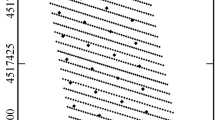Abstract
The analysis and mapping of agronomic and environmental spatial data require observations to be comparable. Heterogeneous spatial datasets are those for which the observations of different datasets cannot be directly compared because they have not been collected under the same set of acquisition conditions, for instance within the same time period (if the variable of interest varies across time), with consistent sensors or under similar management practices (if the management practices impact the measured value) among others. When heterogeneous acquisition conditions take place, there is a need for harmonization procedures to make possible the comparison of such observations. This analysis details and compares four automated methodologies that could be used to harmonize heterogeneous spatial agricultural datasets so that the data can be analysed and mapped conjointly. The theory and derivation of each approach, including a novel, local spatial approach is given. These methods aim to minimize the occurrence of discrepancies (discontinuities) in the data. The four approaches were evaluated and compared with a sensitivity analysis on simulated datasets with known characteristics. Results showed that none of the four methods consistently delivered a better harmonization accuracy. The accuracy and preferred choice for the harmonization procedures was shown to be influenced by (i) within-field spatial structures of the datasets, (ii) differences in acquisition conditions between the heterogeneous spatial datasets, and (iii) the spatial resolution of the simulated data. The four approaches were used to harmonize real within-field grain yield datasets and a discussion to help users select an appropriate harmonization methodology proposed. Despite significant improvements in dataset harmonization, discontinuities were not entirely removed and some uncertainty remained.







Similar content being viewed by others
References
Acevedo-Opazo, C., Tisseyre, B., Guillaume, S., & Ojeda, H. (2008). The potential of high spatial resolution information to define within-vineyard zones related to vine water status. Precision Agriculture, 9, 285–302.
Bartholomeus, R. P., Witte, J. P. M., van Bodegom, P. M., & Aerts, R. (2008). The need of data harmonization to derive robust empirical relationships between soil conditions and vegetation. Journal of Vegetation Science, 19, 799–808.
Baume, O., Skøien, J., Carré, F., Heuvelink, G., & Pebesma, E. (2009). Data harmonization of environmental variables: From simple to general solutions. In J. Hřebíček, J. Hradec, E. Pelikán, O. Mírovský, W. Pilmmann, I. Holoubek, & T. Bandholz (Eds.), European conference of the Czech presidency of the council of the European Union towards environment (pp. 162–169).
Baume, O., Skøien, J. O., Heuvelink, G. B. M., Pebesma, E. J., & Melles, S. J. (2010). A geostatistical approach to data harmonization—Application to radioactivity exposure data. International Journal of Applied Earth Observation and Geoinformation, 13, 409–419.
Bivand, R. S., Pebesma, E. J., & Gomez-Rubio, V. (2013). Applied spatial data analysis with R. New York, NY, USA: Springer.
Brenning, A., Koszinski, S., & Sommer, M. (2008). Geostatistical homogenization of soil conductivity across field boundaries. Geoderma, 143(3), 254–260.
Brent, R. (1973). Algorithms for minimization without derivatives, Chap. 4. Englewood Cliffs, NJ, USA: Prentice-Hall.
Fassó, A., Cameletti, M., & Nicolis, O. (2007). Air quality monitoring using heterogeneous networks. Environmetrics, 18, 245–264.
Köhl, M., Traub, B., & Païvinen, R. (2000). Harmonization and standardization in multi-national environmental statistics—Mission impossible? Environmental Monitoring and Assessment, 63, 361–380.
Leroux, C., Jones, H., Clenet, A., Dreux, B., Becu, M., & Tisseyre, B. (2017). Simulating yield datasets: An opportunity to improve data filtering algorithms. In J. A. Taylor, D. Cammarano, A. Prashar, & A. Hamilton (Eds.), Proceedings of the 11th European conference on precision agriculture. Advances in Animal Biosciences, 8, 600–606.
Leroux, C., Jones, H., Clenet, A., & Tisseyre, B. (2018). A general method to filter out defective spatial observations from yield mapping datasets. Precision Agriculture, 19, 789–808.
Maldaner, L. F., Molin, J. P., & Canata, T. F. (2016). Processing yield data from two or more combines. In Proceedings of the 13th international conference on precision agriculture. Retrieved March, 2019, from https://www.ispag.org/proceedings/?action=abstract&id=1965&search=years.
McBratney, A. B., & Pringle, M. J. (1999). Estimating average and proportional variograms of soil properties and their potential use in precision agriculture. Precision Agriculture, 1, 125–152.
Oliver, M. A. (2010). Geostatistical applications for precision agriculture. London, UK: Springer.
Pringle, M. J., McBratney, A. B., Whelan, B. M., & Taylor, J. A. (2003). A preliminary approach to assessing the opportunity for site-specific crop management in a field, using a yield monitor. Agricultural Systems, 76, 273–292.
Sams, B., Litchfield, C., Sanchez, L., & Dokoozlian, N. (2017). Two methods for processing yield maps from multiple sensors in large vineyards in California. In J. A. Taylor, D. Cammarano, A. Prashar, & A. Hamilton (Eds.), Proceedings of the 11th European conference on precision agriculture. Advances in Animal Biosciences, 8, 530–533.
Skøien, J. O., Baume, O., Pebesma, E. J., & Heuvelink, G. B. M. (2010). Identifying and removing heterogeneities between monitoring networks. Environmetrics, 21, 66–84.
Webster, R., & Oliver, M. A. (1992). Sample adequately to estimate variograms of soil properties. Journal of Soil Science, 43, 177–192.
Weller, U., Zipprich, M., Sommer, M., Castell, W. Z., & Wehrhan, M. (2007). Mapping clay content across boundaries at the landscape scale with electromagnetic induction. Soil Science Society of America Journal, 71, 1740–1747.
Acknowledgements
This work, referred as ANR-16-CONV-0004, was supported by the French National Research Agency under the “Investments for the Future Program.”
Author information
Authors and Affiliations
Corresponding author
Additional information
Publisher's Note
Springer Nature remains neutral with regard to jurisdictional claims in published maps and institutional affiliations.
Rights and permissions
About this article
Cite this article
Leroux, C., Jones, H., Pichon, L. et al. Automatic harmonization of heterogeneous agronomic and environmental spatial data. Precision Agric 20, 1211–1230 (2019). https://doi.org/10.1007/s11119-019-09650-0
Published:
Issue Date:
DOI: https://doi.org/10.1007/s11119-019-09650-0




